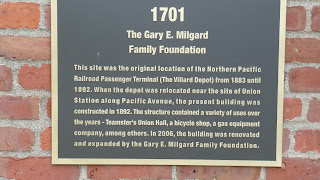The Milgard Family
Trust is currently housed in the
building at 1701 Commerce . This last building on campus before Tollefsen
Plaza was the site of the first passenger terminal in Tacoma for the Northern
Pacific Railroad before it was moved across Pacific Avenue in 1892 to the site
where Union Station ,erected in 1911, now stands as part of the Federal Court
House. The Villard Depot served the
train passenger community from 1883 until 1992. The Milgard Family Trust is
named for Gary Milgard who selected as a permanent member by the Horatio Alger
Association Of Distinguished Americans in 2003. The members of this association
mentor young and provide scholarships to high school seniors who have proven their
ability to overcome childhood adversities and humble beginnings.
The building we
see today was originally built in 1894 as the Teamsters and Chauffeurs hall
which they used as their hiring hall for half a century. Merit Architects bought the Teamsters hiring
hall in 1979 and remodeled the building, a project that lasted three years, and
used it as their architectural offices until the University of Washington
Tacoma required the property for their
expansion. A number of other businesses occupied the building over the years
including a bicycle shop, a sheet metal fabricator, and Pettit Oil Company,
affiliated with Standard Oil, it apparently operated a number of Chevron
Stations in the area including one across 17th Street which occupied a portion of what is now
Tollefsen Plaza.
The shape and size
of the building were determined by the property set-backs of the time, 1894,
when it was built. Hence, the triangular shape forced by 17th
Street, Commerce Street and the Railroad’s Hood corridor all of which are
easily identifiable today. This wedge shape often referred to as a keystone
building
because of its
resemblance to the center topmast stone in a masonry arch stands today
reflected in the University of Washington Tacoma’s Keystone Building. These two
keystone building form a unique relationship in my experience as they point
toward each other. While there are numerous keystone building in Tacoma and
across America this is the only place, again by my experience, where two of
them sit in this juxtaposition. Both buildings are defined by commerce, 17th
and Hood corridor. They appear like spokes
to a circle or as if forming their own intersection which could be
expanded to include connections with Duggan Hall, West Coast Grocery building and the Joy building. This crossroads
is demarked by the railroad crossing signal warning towers seems like a natural
for a small square or CIRCLE for the
University landscape. Many shapes can form a matrix for building construction
as well as plazas, decks, and contrived landscape features including the
square, the rectangle, the hexagram and the circle as well as the nodal points
of intersecting circles.
With four of the various occupants of 1702 Commerce having business that involve wheels: The teamsters were driving horse drawn wagons before trucks; the train depot depended on the wheels of trains; The bicycle shop; and the Chevron business required cars and trucks, it seems fitting that a design would include circles, wheels or some combination or intersection of such.



.png)



























